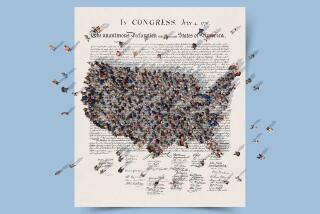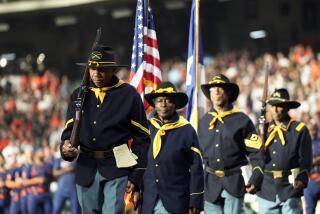The Meaning of Jefferson’s Declaration
- Share via
AMHERST, MASS. — The Declaration of Independence we commemmorate this long weekend is the best known and probably most deeply cherished of U.S. documents. Yet its real function was not to declare independence--that had already been taken care of by George III when he declared the Americans to be in a state of rebellion, and by the Americans at the battles of Lexington, Concord and Bunker Hill.
No, its purpose was to make clear the causes of separation and the objects of independence. As Thomas Jefferson put it, “to place before mankind the common sense of the subject in terms so plain and firm as to justify ourselves. It was intended to be an expression of the American mind.” The justification came in one form at Yorktown, and in another at the Constitutional Convention in Philadelphia. That “expression” of the American mind can be read best in the preamble--the only part of the declaration anyone reads now.
The preamble sets forth, with moving eloquence, a series of “self-evident truths”: that all men are “created equal” and endowed with inalienable rights--among them life, liberty and the pursuit of happiness; that governments are “instituted” by men and derive all their just powers from the consent of the governed, and that the people have the right to alter or abolish their governments and create new governments to protect their safety and happiness.
Of all these principles the most important--and most controversial--is the assertion “all men are created equal.”
Neither Jefferson nor the American people discovered or invented these “truths.” They were drawn from the works of ancient Greece and Rome; they had been elaborated by philosophers like John Milton and John Locke during England’s Commonwealth; they were the taken-for-granteds of the 18th Century Enlightenment; they had been Americanized by Colonial liberals from Roger Williams to James Otis, and popularized by Tom Paine. What Americans did, in the declaration, in state and national constitutional conventions and bills of rights was more important than adopting them--it was in realizing them.
The implementation of most of the declaration’s entitlements was not difficult. Men could, and did, make governments in the 13 states and new communities in the West, where they took authority into their own hands, decreeing bills of rights and writing laws. They could, and did, set limits to governments, alter and abolish them and create new ones. They could assure rights by drawing up bills of rights which, unlike those in England, provided guarantees of substantial, not just procedural, rights; and enforce these in independent courts.
That all went smoothly enough. But how to implement Jefferson’s philosophical principles? How vindicate the principle that all men are created equal and endowed with life, liberty and the right to pursue happiness? That was the most troublesome, and elusive, of all the commitments of the declaration--and still is. What did Jefferson mean by the assertion that “all men are created equal”? What did the 57 men who signed it mean? This we do not know, not with any certainty. But we know what Jefferson meant.
Jefferson meant what he wrote--quite literally. It is not only that Jefferson was a child of the Enlightenment--indeed the best representative--but that he was passionately devoted to freedom: physical, intellectual and religious freedom in every legitimate form.
As early as 1773, he had argued in court that slavery was against natural law, and therefore non-existent in Virginia. He wrote into the declaration a vitriolic section denouncing the slave trade only to have it removed by his fellow committee members.
It was Jefferson who wrote into the ordinances of the West that slavery should never exist in the new Western territory--Congress voted down that provision, but left all territory north of the Ohio River free. In 1787 he wrote, “This abomination must have an end.” When, at the close of his life, he created the University of Virginia, he dedicated it “to the illimitible freedom of the human mind.”
Jefferson’s conviction that all men were created equal was not merely a humanitarian sentiment. It was, he was convinced, a scientific fact. With Benjamin Franklin, Jefferson was what the 18th Century called a “natural philosopher”--what we call a scientist. As such he accepted the fact that all men were equal at birth, under the laws of nature.
Physically there were no differences between blacks and whites; whatever differences emerged were the product of man and his laws. Violent intervention in the laws of nature--slavery--must inevitably fail. As slavery was a rebellion against the laws of nature, it stood condemned by reason and should be condemned by law. That prophesy found an answer less than a century later within 100 miles of Jefferson’s Monticello.
But let us close on a more propitious note. The day after the decisive vote for independence in the Continental Congress, on July 3, 1776, John Adams wrote his beloved Abigail:
“Yesterday the greatest question was decided which ever was debated in America.” And that night he dashed off another letter:
“You will be transported with enthusiasm, but I am not. I am well aware of the toil and blood and treasure that it will cost us to maintain this Declaration and support and defend these states. Yet through all the gloom I can see the rays of ravishing glory. I can see that the end is worth more than all the means and that posterity will triumph in that day’s transaction, even though we should rue it, which I trust in God we shall NOT.”
More to Read
Sign up for Essential California
The most important California stories and recommendations in your inbox every morning.
You may occasionally receive promotional content from the Los Angeles Times.












